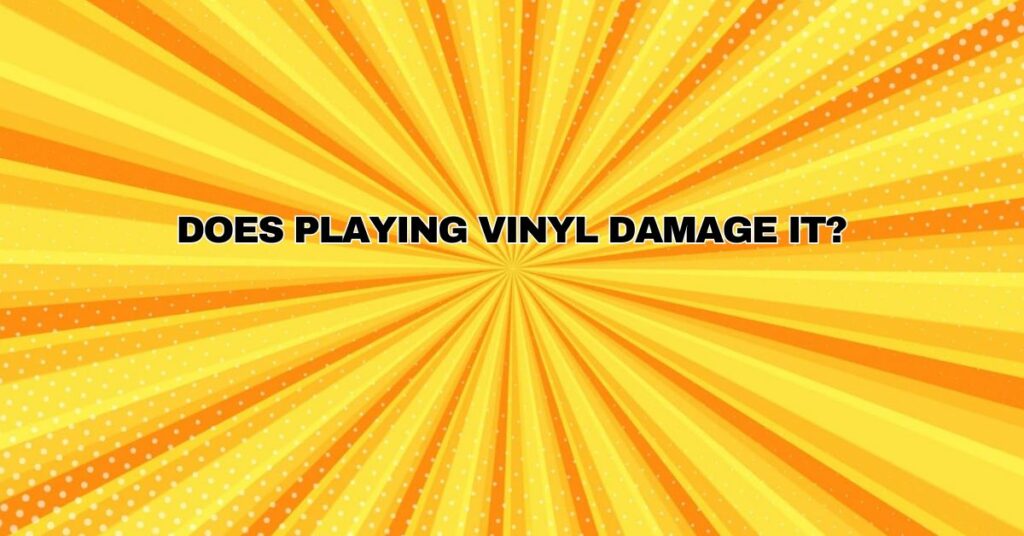The vinyl record, with its warm analog sound and tactile charm, remains a beloved format for music enthusiasts and collectors alike. However, a persistent myth surrounds vinyl records—that playing them inevitably leads to damage or degradation. In this comprehensive article, we will explore the reality of vinyl record durability, the factors that can influence their condition, and best practices for maintaining and enjoying your vinyl collection without causing harm.
Vinyl Records: The Basics
Before delving into the potential for damage, it’s essential to understand the fundamental structure of vinyl records:
- Vinyl Composition: Vinyl records are made from a vinyl compound known as polyvinyl chloride (PVC). This material is both durable and flexible, making it ideal for the creation of grooves that carry audio information.
- Groove Formation: The music on a vinyl record is encoded in the form of tiny grooves. A stylus, or needle, traces these grooves as the record spins, converting the physical undulations into an analog audio signal.
- Handling and Playback: Proper handling and playback involve carefully placing the stylus on the record, allowing it to track the grooves accurately while minimizing unnecessary wear and tear.
Dispelling Myths About Vinyl Damage
Myth 1: Playing Vinyl Records Wears Them Out
One common misconception is that each play of a vinyl record results in irreparable damage. While it’s true that physical contact between the stylus and the record’s grooves occurs during playback, vinyl records are surprisingly resilient. Here’s why:
- Hardness Differential: Vinyl records are made from a relatively hard material (PVC), while the stylus is typically made of a softer material, often diamond or sapphire. This hardness differential means that the stylus wears down over time, rather than the record itself.
- Material Composition: Vinyl is a durable and long-lasting material. Records pressed in the mid-20th century are still playable today, attesting to their longevity.
- Vinyl Thickness: Vinyl records have a relatively thick layer of vinyl, which allows for repeated plays without significant wear. Audiophiles often use terms like “trackability” and “record life” to describe this resilience.
Myth 2: Record Players Destroy Vinyl Records
Another misconception is that record players themselves are inherently destructive to vinyl records. While poorly maintained or improperly set up turntables can potentially cause damage, well-maintained turntables are not inherently harmful. Factors to consider include:
- Tracking Force: Setting the correct tracking force (the pressure applied by the stylus) is essential. Too much tracking force can cause excessive wear on both the stylus and the record, while too little force can result in tracking errors.
- Anti-Skate Mechanism: Many turntables are equipped with an anti-skate mechanism to counteract the natural tendency of the tonearm to move toward the center of the record. Properly adjusted anti-skate helps maintain even wear.
- Needle Condition: Regularly inspect and replace the stylus as needed. A worn or damaged stylus can cause excessive wear and groove damage.
- Turntable Maintenance: Keep your turntable clean and well-maintained to prevent dust and debris from interfering with playback.
Factors That Influence Vinyl Damage
While vinyl records themselves are robust, several factors can influence their condition:
- Dirt and Debris: Dust, dirt, and debris on the record’s surface can be problematic. When the stylus encounters these particles, it can create surface noise and potentially cause physical damage.
- Poor Handling: Mishandling vinyl records, such as touching the grooved surface, can transfer oils and dirt onto the record. Always handle records by their edges.
- Stylus Condition: A worn or damaged stylus can exert excessive pressure on the grooves, leading to groove wear and damage.
- Record Storage: Proper storage is crucial to prevent warping, mold, and other potential issues. Store records vertically, away from direct sunlight and extreme temperatures.
- Record Cleaning: Regular cleaning of records and stylus helps maintain optimal playback conditions and minimizes damage from dirt and debris.
Best Practices for Vinyl Record Care
To ensure the longevity of your vinyl records and enjoy them without causing damage, consider the following best practices:
- Cleanliness: Keep your records clean by using a record cleaning brush, anti-static brush, or a record cleaning machine. Ensure your stylus is also clean.
- Storage: Store records in a cool, dry, and upright position. Use anti-static inner sleeves to protect records from dust and static.
- Handling: Handle records by their edges to avoid transferring oils and dirt to the grooved surface. Use a clean stylus brush or stylus cleaner.
- Proper Playback: Maintain your turntable and set the correct tracking force and anti-skate settings. Replace the stylus when it shows signs of wear.
- Rotation: Rotate your records periodically to prevent excessive groove wear on a single track.
Conclusion
Vinyl records are more resilient than commonly believed, and playing them is not inherently damaging. In fact, regular playback can help maintain the health of your records by preventing dust buildup and groove degradation. Proper handling, storage, and maintenance practices are essential to ensuring the longevity and audio quality of your vinyl collection. By following these best practices, you can continue to enjoy the unique analog sound and tactile pleasure of vinyl records for years to come, without fear of causing undue harm.


